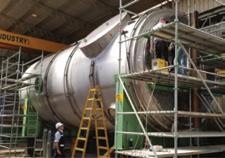
4 minute read
NORaM’s hot sweep cold exchanger does the trick
By: Guy Cooper*, Andres Mahecha-Botero, Werner Vorster, NORAM Engineering and Constructors Ltd., Vancouver, Canada.
increasing acid production using split flow heat exchangers
In early 2017, NORAM completed a capacity increase study for a client’s two sulfur burning acid plants. A key finding was that the cold reheat exchanger in both plants contributed significantly to plant pressure drop due to cold end fouling and design. Because of mechanical integrity concerns with one of the exchangers, the client decided to replace it and selected a NORAM cold exchanger with NORAM’s proprietary hot sweep feature.
Cold and cold interpass conventional exchangers
In a cold interpass exchanger, the cooled SO3 gas leaves the gas exchanger en route to an economizer before entering the interpass tower. The counter-current gas in a cold interpass exchanger in a sulfur burning plant is the cold SO2 gas from the interpass tower. For a cold exchanger in a smelter or acid regeneration plant, the cold SO2 gas can also be from the drying tower. In both cases metal temperatures at, or below, the gas dewpoint are likely. Condensation can occur and weak acid is formed which reacts with the metal to form iron sulphate. In a carbon steel gas exchanger the sulfate formation can be considerable, resulting in short exchanger lifespans. Standard stainless-steel exchangers have significantly less sulfate corrosion but, over time, fouling and plugging will occur.
noraM’s hot sweep feature
To address the cold end condensation problem found in cold and cold interpass gas exchangers, NORAM developed and patented a split flow exchanger with a hot sweep feature. This exchanger takes a slipstream of the hot SO3 shell gas and introduces it to the cold end of the exchanger adjacent to the entry of the cold SO2 gas. This hot gas warms up the top of the bottom tube sheet of the gas exchanger and flows co-currently with the SO2 gas for a short distance. This SO3 gas then co-mingles with the counter-current SO3 gas and exits the exchanger. The result is the bottom of the exchanger is significantly warmed up well above the sulfuric acid dewpoint, greatly reducing the chance of condensation and corrosion. A schematic is shown in Fig. 1. NORAM has been supplying this popular style of gas exchanger for over 21 years now with the original unit, installed in 2000, still in service.
37th


Oil | Gas | Fertilizers | Metallurgy | Industrial
Sulphur + Sulphuric Acid 2021
1-3 November 2021
CALL FOR PAPERS DEADLINE14 MAY 2021
CRU Sulphur + Sulphuric Acid 2021 is the global gathering for the sulphur and acid industries to meet, learn, and do business.
Why submit an abstract?
The conference is an ideal platform to demonstrate thought-leadership and operational experience, or showcase your product or service to a large global audience of technical experts.
What subjects are we looking for?
We welcome operational case studies, and/or new technology, process, materials or equipment developments, that offer the potential of improved reliability, safety, environmental or production efficiencies.
Where can I go for more information? Visit the website www.sulphurconference.com or contact amanda.whicher@crugroup.com

Fig. 1: Flow arrangement for NORaM’s Cold Interpass gas exchanger with Hot Sweep.
exchanger design aspects
When NORAM designs replacement sulfuric acid equipment, key considerations are to provide equipment with improved performance compared to the existing while matching the gas ducting. For this replacement exchanger, NORAM’s design accommodated the higher duty required for the planned capacity increase with 2/3 of the pressure drop of the existing exchanger, and minimal ducting changes. On top of those benefits, NORAM’s improved design had ¾ of the tube surface area compared to the existing old-style exchanger. All of these features, coupled with the benefit of a hot sweep to minimize condensation, ensures excellent long-term performance at a very competitive price.
fabrication
For large sulfuric acid equipment, shipping can often present challenges. For a gas exchanger, it is preferred to shop fabricate and ship the unit in one piece to the site. For this project, the client provided the names of local fabricators. NORAM inspected and qualified a fabricator in close shipping proximity to the plant site and retained a local quality inspector to assist NORAM engineers, who visited the fabricator and site frequently to ensure the highest-quality final product was delivered.
delivery and start-up
Fabrication was uneventful, which is always good, and the exchanger was delivered on time. The client installed the exchanger; NORAM provided installation and start-up assistance. NORAM and the client were both pleased with the performance.

NORaM engineer inspects fabrication of cold exchanger.

Transporting large NORaM gas exchanger.

Installing NORaM Cold Ip gas exchanger with Hot Sweep.
next unit
Fast forward two years after the installation of the first unit. At the first turnaround, the client inspected the now two-year-old NORAM gas exchanger and was satisfied to see a clean exchanger compared to the sulfate fouling of the previous unit. This demonstrated performance made it easy for the client to award NORAM a second cold exchanger with hot sweep for the other acid plant in the same site. This second hot sweep exchanger is currently under fabrication and will have half the pressure drop, significantly less area, and greater capacity compared to the existing fouled exchanger. The new exchanger will be shipped to site in the second quarter 2021.
NORAM Engineering and Constructors Limited designs and supplies sulfuric acid equipment. They have designed and supplied over 120 radial flow gas exchangers. For more information, email acid@noram-eng. com or visit www.noram-eng.com. *Corresponding Author: C. Guy Cooper., P.Eng. gcooper@noram-eng. com, phone (604) 724-8219 q








